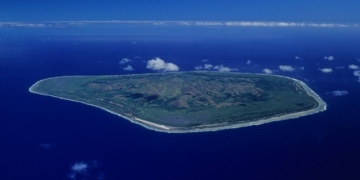According to the National Center for Hydro-Meteorological Forecasting, as of 4 AM on August 31, the center of Typhoon No. 3 was located at approximately 21 degrees North latitude and 118.5 degrees East longitude, over the northeastern waters of the North East Sea, about 510 km southeast of Hong Kong (China). The strongest winds near the center of the typhoon reached level 16 (184-201 km/h), with gusts exceeding level 17, moving in a west-northwest direction at a speed of approximately 10-15 km/h.
By 4 AM on September 1, the center of the typhoon was at 22.3 degrees North latitude and 116.5 degrees East longitude, over the northeastern waters of the North East Sea, about 280 km east-southeast of Hong Kong (China). The storm was moving northwest at a speed of about 10-15 km/h, with intensity levels of 14-15, and gusts exceeding level 17. The dangerous zone affected by the storm extends to the north of latitude 18 degrees North and the east of longitude 114 degrees East; the northeastern region of the North East Sea faces a level 3 natural disaster risk.

Forecast path of Typhoon No. 3. (Image: nchmf.gov.vn).
By 4 AM on September 2, the center of the typhoon was located at 22 degrees North latitude and 114.2 degrees East longitude, over the southeastern waters of Guangdong Province (China). The storm was moving west at a speed of about 10 km/h, with intensity levels of 13-14 and gusts at level 17. The dangerous zone affected by the storm extends to the north of latitude 18.5 degrees North and the east of longitude 112 degrees East; the northern area of the North East Sea has a level 3 natural disaster risk.
By 4 AM on September 3, the center of the typhoon was at 21.3 degrees North latitude and 112.1 degrees East longitude, over the southwestern waters of Guangdong Province (China). The storm was moving west-southwest at a speed of about 10 km/h, with intensity levels of 11-12 and gusts at level 15. The dangerous zone affected by the storm extends to the north of latitude 18.5 degrees North and the east of longitude 110.5 degrees East; the northern area of the North East Sea has a level 3 natural disaster risk.
From 72 to 120 hours ahead, the storm is expected to primarily move west-southwest at a speed of 5-10 km/h, with the intensity likely to gradually decrease.
Due to the impact of the storm, on August 31, the northeastern waters of the North East Sea experienced strong winds at levels 9-10, later increasing to levels 11-13, while near the storm’s center reached levels 14-16, with gusts exceeding level 17; the sea was highly turbulent. In the eastern region of the North East Sea, wave heights were between 4-6 meters, later increasing to 8-10 meters.
From August 31 to the night of September 1, the southern Central Highlands and Southeast region are expected to experience moderate to heavy rain, with some areas receiving very heavy rainfall and scattered thunderstorms, accumulating between 50-100 mm, and in some places over 150 mm. The northern Central Highlands and the western Mekong Delta may see scattered rain and thunderstorms, with localized heavy rain of 20-50 mm, and some areas exceeding 90 mm (with rainfall concentrated in the afternoon and night).
Additionally, on the day and night of August 31, the central and southern Central regions are likely to receive scattered rain and thunderstorms, with localized moderate to heavy rain of 10-30 mm, and some areas over 70 mm (with rainfall concentrated in the late afternoon and evening).
Thunderstorms and localized heavy rain in the southern Central region, Central Highlands, and southern regions may continue over the coming days. The risk level for natural disasters due to thunderstorms and lightning is rated at level 1.
Residents are advised to be cautious of the risk of flash floods and landslides in mountainous areas and flooding in low-lying regions; be aware of heavy rainfall in a short period that may cause urban flooding; during thunderstorms, there is a possibility of tornadoes, lightning, hail, and strong winds occurring.


















































